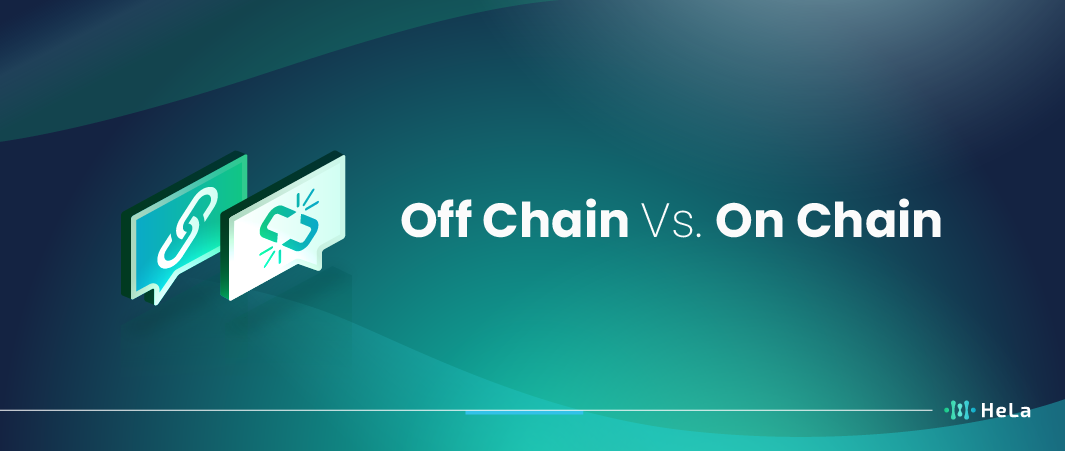In the ever-evolving world of blockchain technology, the concepts of ‘off-chain’ and ‘on-chain’ transactions have become increasingly significant. These terms, often tossed around in the realms of cryptocurrency and digital ledgers, represent two distinct methods of processing and storing data. Understanding the differences between these approaches is crucial for anyone involved in the blockchain sector, whether as a developer, investor, or enthusiast. This article aims to demystify these terms, providing a clear understanding of their implications, risks, and rewards.
On-chain transactions are those that occur directly on the blockchain and are recorded on the public ledger. This method is known for its transparency, security, and immutability. On the other hand, off-chain transactions happen outside the blockchain network, offering advantages like faster processing times and reduced transaction costs. However, they also come with their own set of risks and limitations.
As blockchain technology continues to mature, the debate between off-chain and on-chain methods grows more nuanced. This article will delve into the technicalities, use cases, and implications of each approach, helping readers navigate the complex landscape of blockchain transactions.
The Basics of On-Chain Transactions

On-chain transactions are a fundamental aspect of blockchain technology. These are transactions that occur on a blockchain and are recorded on the distributed ledger. Every on-chain transaction is validated and confirmed by the network’s nodes, making them irreversible and secure. This process includes several key components:
- Transaction Request: A user initiates a transaction by submitting a request to transfer digital assets, like cryptocurrencies, from one address to another.
- Validation: Network nodes (or miners in some blockchains) validate the transaction. This involves checking the transaction’s integrity and the sender’s balance.
- Block Formation: Once validated, the transaction is grouped with other transactions to form a new block.
- Block Confirmation: The new block is then added to the existing blockchain after a consensus is reached among the nodes. This involves a specific algorithm, like Proof of Work or Proof of Stake, depending on the blockchain.
- Immutable Record: The transaction is now recorded on the blockchain, providing a transparent, immutable, and tamper-proof record.
- Transaction Finality: After being recorded on the blockchain, the transaction is considered final and irreversible.
On-chain transactions are distinct from off-chain transactions, which are processed outside the blockchain network and later reconciled with the on-chain ledger. The on-chain process ensures security and transparency but can lead to slower processing times and higher fees, depending on the network’s congestion and the blockchain’s architecture.
Exploring Off-Chain Transactions
Off-chain transactions refer to a crucial concept within the realm of blockchain technology and cryptocurrency. In the world of blockchain, transactions are typically recorded on a decentralized ledger, visible to all participants on the network. These transactions are considered “on-chain” and are secured through various consensus mechanisms like Proof of Work (PoW) or Proof of Stake (PoS).
However, off-chain transactions introduce an alternative approach to handling transactions. Instead of recording every single transaction directly on the blockchain, certain transactions and data are processed and settled off the main blockchain network. This approach is particularly beneficial in several scenarios:
- Scalability: Off-chain transactions can significantly improve the scalability of blockchain networks. By reducing the volume of data recorded on the main chain, the network can handle a higher number of transactions per second without congesting the blockchain.
- Speed and Cost-Efficiency: Off-chain transactions are typically faster and involve lower transaction fees compared to on-chain transactions. This makes them suitable for microtransactions, high-frequency trading, and various applications where speed and cost-effectiveness are paramount.
- Privacy: Off-chain transactions can enhance privacy by concealing transaction details from the public blockchain. Parties involved in an off-chain transaction can execute private agreements without exposing sensitive information to the broader network.
- Enhanced Functionality: Off-chain transactions enable more complex and interactive smart contracts and applications. They allow for activities like state channels, which enable off-chain execution of smart contract logic, and facilitate interactive gaming, voting, and instant payments.
To implement off-chain transactions, various solutions and technologies have been developed, including:
- Lightning Network (for Bitcoin): Lightning Network is a second-layer solution built on top of the Bitcoin blockchain. It enables fast and low-cost transactions by creating payment channels between users, allowing them to transact off-chain while periodically settling their balances on the main chain.
- Raiden Network (for Ethereum): Similar to Lightning Network, the Raiden Network is designed for the Ethereum blockchain. It facilitates off-chain token transfers and provides scalability improvements for Ethereum applications.
- Sidechains: Sidechains are separate blockchain networks that are interoperable with the main blockchain. They allow for off-chain transactions and smart contract execution, enabling experimentation with new features and scalability improvements without impacting the main chain’s security.
- State Channels: State channels are a more generic approach that can be applied to various blockchain platforms. They enable participants to conduct off-chain interactions and only settle the final outcome on the main chain, reducing congestion and transaction costs.
Off-chain transactions play a vital role in addressing some of the limitations of blockchain technology, such as scalability and cost-efficiency. They offer various benefits, including improved speed, privacy, and functionality, and are implemented through a range of innovative solutions and technologies tailored to different blockchain ecosystems. Understanding the intricacies of off-chain transactions is crucial for anyone interested in the evolving landscape of blockchain and cryptocurrency.
Also Read: Solving Gas Fee Volatility with Stablecoins
Comparing Risks and Security Features

Off-chain and on-chain refer to two different approaches in the context of blockchain technology and cryptocurrency. Each has its own set of risks and security features. Let’s compare them:
On-Chain Transactions Security Features
- Immutability: On-chain transactions are recorded on the blockchain, which is a decentralized and immutable ledger. Once a transaction is confirmed, it cannot be altered or deleted, enhancing security.
- Transparency: All on-chain transactions are publicly visible, providing transparency and accountability.
- Decentralization: Blockchains are typically decentralized networks, making it difficult for a single entity to control or manipulate transactions.
On-Chain Transactions Risks
- Slower Confirmation Times: Depending on the blockchain’s design, on-chain transactions may take longer to confirm due to the consensus mechanisms and block generation times.
- Higher Costs: On-chain transactions often involve transaction fees, which can be relatively high during periods of network congestion.
- Scalability Issues: Some blockchains face scalability challenges, resulting in congestion during high-demand periods, which can slow down transactions and increase fees.
Off-Chain Transactions Security Features
- Speed: Off-chain transactions are typically faster and more scalable than on-chain transactions because they don’t require the same level of consensus and verification.
- Lower Costs: Off-chain transactions often have lower fees, making microtransactions more feasible.
- Privacy: Some off-chain solutions offer enhanced privacy features, allowing for confidential transactions.
On-Chain Transactions Risks
- Trust Dependency: Off-chain transactions often rely on trusted intermediaries or payment channels, introducing counterparty risk. Users must trust these intermediaries to facilitate transactions honestly.
- Limited Transparency: Transactions that occur off-chain may not be as transparent as on-chain transactions. This lack of transparency can be a concern for some users and regulators.
- Centralization Potential: Some off-chain solutions may introduce centralization in certain aspects, potentially compromising the decentralized nature of blockchain technology.
The choice between on-chain and off-chain transactions depends on the specific use case and trade-offs you are willing to make. On-chain transactions offer strong security and decentralization but can be slower and more expensive. Off-chain solutions provide speed and cost advantages but may introduce trust dependencies and reduced transparency. Balancing these factors is essential when designing or choosing a blockchain-based system. Many blockchain projects aim to strike a balance by using a combination of both on-chain and off-chain solutions to optimize security, scalability, and cost-effectiveness.
Understanding the Impact on Blockchain Efficiency
Blockchain technology is often touted for its transparency, immutability, and decentralized nature. However, these advantages come at a cost, mainly in terms of computational and storage resources. In this context, “Off Chain” and “On Chain” refer to two different approaches for handling certain operations or data within a blockchain ecosystem.
On-Chain Operations
This refers to actions or transactions that are executed directly on the blockchain itself. In a typical cryptocurrency blockchain, every transaction, smart contract execution, or interaction with the blockchain network is recorded on the public ledger, which requires consensus among network participants through mining or validation mechanisms. While this ensures security and transparency, it can lead to scalability issues and high transaction costs, especially in popular blockchain networks like Bitcoin or Ethereum.
Off-Chain Operations
In contrast, off-chain solutions involve performing some transactions or computations outside the blockchain. These transactions are not immediately recorded on the public ledger but are instead processed separately. This approach can significantly improve efficiency and scalability, as it reduces the burden on the blockchain network. Various off-chain scaling solutions, such as Lightning Network for Bitcoin and Layer 2 solutions for Ethereum, aim to alleviate congestion and high fees while maintaining the security and trustworthiness of the blockchain.
Understanding the impact of choosing between on-chain and off-chain operations is crucial for blockchain developers, users, and stakeholders. Key considerations include:
- Scalability: On-chain transactions can become slow and expensive as the network becomes congested. Off-chain solutions aim to provide faster and cheaper transactions, improving scalability.
- Security: On-chain transactions are inherently more secure due to the blockchain’s consensus mechanisms. Off-chain solutions must implement additional security measures to ensure the same level of trust.
- Cost: On-chain transactions often come with higher fees, making microtransactions less practical. Off-chain solutions can reduce costs and enable microtransactions.
- Use Cases: Different blockchain applications have varying requirements. Some use cases, such as financial settlements or token transfers, might benefit from off-chain solutions, while others, like smart contracts or digital asset ownership, may require on-chain execution.
- Regulatory Compliance: The choice between on-chain and off-chain can have implications for regulatory compliance, as some jurisdictions may have specific requirements for handling blockchain data and transactions.
Understanding the trade-offs between on-chain and off-chain operations is essential for optimizing the efficiency of blockchain systems. It involves a careful consideration of factors like scalability, security, cost, use cases, and regulatory compliance to make informed decisions about how to design and implement blockchain solutions that best meet the needs of specific applications and users.
Also Read: 5 Ways To Recover Funds From Cryptocurrency Scam
Future Trends and Developments in On-Chain and Off-Chain Transactions

The world of blockchain technology and cryptocurrency transactions is rapidly evolving, with several future trends and developments shaping the landscape of both on-chain and off-chain transactions. On-chain transactions refer to activities that occur directly on a blockchain network, while off-chain transactions involve activities outside the blockchain but still related to cryptocurrency.
One key trend in on-chain transactions is the continued expansion of decentralized finance (DeFi) applications. DeFi platforms allow users to access financial services like lending, borrowing, and trading directly on the blockchain, bypassing traditional financial intermediaries. As DeFi projects mature and become more user-friendly, we can expect to see an increase in the adoption of on-chain transactions for various financial activities.
Another significant development is the improvement of blockchain scalability and efficiency. As blockchain networks like Ethereum work on implementing upgrades such as Ethereum 2.0 and layer-2 scaling solutions, transaction speeds and costs are expected to improve significantly. This will make on-chain transactions more accessible and practical for a broader range of users and applications.
On the other hand, off-chain transactions are also undergoing important developments. The integration of cryptocurrencies into mainstream financial services is becoming more prevalent, with established financial institutions offering custody, trading, and investment options for digital assets. Additionally, regulatory frameworks for cryptocurrencies are expected to become more defined and accommodating, which could further facilitate off-chain transactions and investments in the digital asset space.
Conclusion
In conclusion, the choice between off-chain and on-chain transactions depends on the specific needs and constraints of a blockchain application. On-chain transactions offer unparalleled security and transparency, making them ideal for scenarios where trust and immutability are paramount. However, they can be slower and more expensive, limiting their practicality for high-volume or micro-transactions.
Off-chain transactions, conversely, provide speed and cost-efficiency but at the expense of reduced transparency and security. They are well-suited for applications requiring fast processing times and lower fees. As blockchain technology continues to evolve, we may see innovative solutions that blend the best of both worlds, offering secure, transparent, and efficient transaction methods.
The debate between off-chain and on-chain transactions is not about finding a one-size-fits-all solution but understanding the trade-offs and making informed choices based on the requirements of each use case. As the blockchain landscape continues to evolve, staying informed and adaptable will be key to navigating its challenges and opportunities.
Disclaimer: The information provided by HeLa Labs in this article is intended for general informational purposes and does not reflect the company’s opinion. It is not intended as investment advice or recommendations. Readers are strongly advised to conduct their own thorough research and consult with a qualified financial advisor before making any financial decisions.

Joshua Soriano
I am a writer specializing in decentralized systems, digital assets, and Web3 innovation. I develop research-driven explainers, case studies, and thought leadership that connect blockchain infrastructure, smart contract design, and tokenization models to real-world outcomes.
My work focuses on translating complex technical concepts into clear, actionable narratives for builders, businesses, and investors, highlighting transparency, security, and operational efficiency. Each piece blends primary-source research, protocol documentation, and practitioner insights to surface what matters for adoption and risk reduction, helping teams make informed decisions with precise, accessible content.
- Joshua Soriano#molongui-disabled-link
- Joshua Soriano#molongui-disabled-link
- Joshua Soriano#molongui-disabled-link
- Joshua Soriano#molongui-disabled-link

